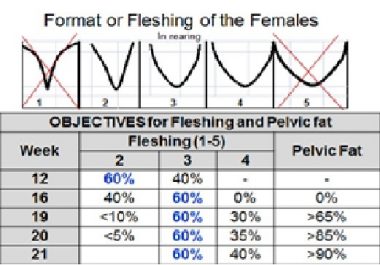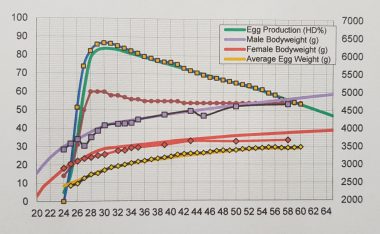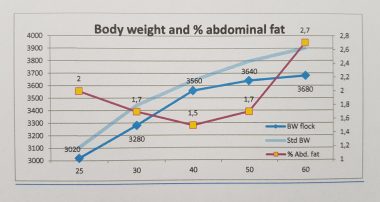The breeder industry is well aware that management and nutrition of parent stock play a key role in achieving the maximum number of strong and vital chicks with good vitality. Various aspects of parent stock management considerably influence chick quality. Such aspects are: uniformity of female frame and egg weight, female condition (fleshing & fat reserves) at moment of light stimulation (MOLS), vaccination program and quality of the hatching eggs.
By Ing. Winfridus Bakker
World technical support manager
Cobb-Vantress
Siloam Springs
AR USA
Broiler growers normally don’t like to receive chicks from young breeders. The chicks are smaller and normally with higher first week mortality. It is important for these small chicks to be uniform, which comes from egg and yolk uniformity relating to how we manage hens in rearing.
In the first eight weeks frame uniformity is achieved and from 16 weeks fleshing and fat uniformity is important for good sexual uniformity of the hens. The hens should be as close as possible in size and development throughout rearing.
In figure 1 an average uniformity is observed for the Cobb500 FF breeder tracking the average egg weight and uniformity over an egg packer so that all the hatching eggs of a flock are being traced. As can be seen in this figure, the average uniformity is just below 90% and on average 88% with ±10% spread. This means that chicks hatched from these eggs should have uniformity above 80% at hatch, which is a good number for starting chicks on a broiler farm. At 25 weeks of age the hatching eggs over 50 grams already reach uniformity above 80% and then climb fast to 89% to stabilize.

Figure 1
Female condition at light stimulation
In large integrations it is seen that there is a positive correlation between total feed amount consumed or bodyweight condition of the parent females at the end of rearing (147 days of age) and broiler livability at seven days of age from young breeders.
Parent flocks with not enough nutrient intake or the wrong body condition show the highest first week mortality in broiler chicks in the first 6 weeks of the young parent stock with a negative impact on final broiler results.

Table 1
Table 1 is an example of how mortality and feed intake (female nutrient intake) can show its effect on mortality in first 7 days of age not to mention the impact on uniformity and final results (body weight and feed conversion).
Breeder companies improve broiler feed conversion in the broilers by enhancing growth rate, selecting for larger portions of breast muscle and reducing total body fat. This body fat is a key component at first light stimulation to obtain:
- Good sexual synchronization of the females,
- High peak production and persistency,
- High early hatchability, and good chick quality and vitality,
- Reduced mortality in females going to peak production,
- Low percentage of floor eggs.
Getting the right amount of body fat that we can measure through weighing abdominal fat deposition is often not easy to obtain. After 12 weeks – start of puberty — it is important to get the females in the proper condition at specific ages. This condition can be expressed in a fleshing score and a pelvic fat score
(table 2).

Table 2
One of the problems we see in many companies is that females and males are not handled often enough to evaluate their condition at crucial ages. Many technicians prefer to enter the weekly average bodyweights in the computer program together with feed intake and uniformity without knowing the condition of the hens. Computer data should be supported by what is seen in the house.
High uniformity rates on paper, but low uniformity at bird level, is a problem of insufficient man-to-bird contact. You should avoid competing with other companies, or complexes within the company, for the lowest feed intake in rearing. You reap in production what you do in rearing — and over-restricting pullets or not having hens in the right condition at light stimulation is a huge mistake.
Good enough fat deposition is extremely important but how do we get this?
- Determine at what age the breeders should start egg production (23-24 or 25 weeks of age) within your integration.
- Develop a feeding program that guarantees that at first light stimulation more than 95% of the females have a fleshing #3 and #4 (scale from 1 to 5) and more than 90% of the females have pelvic fat (table 2).
- Evaluate with your feed formulation what is the condition of the females at 12, 16, 19 and 21 weeks in fleshing and do at 19 and 21 weeks of age also pelvic fat scoring.
- These numbers are then saved in a table and compared to a standard like the one in table 2.
- Only when the standards are reached @ 21 wks (147 days) is the flock ready for first light stimulation and this can happen in the above example at 148 days of age.
- However, do not chase pelvic fat after 154 days of age. Normally at this age you have to light stimulate the flock even if the pelvic fat is not there yet in most of the birds. The reason is that waiting longer than 154 days will give too high body weights in general, which can also have a detrimental effect on peak production.
- Determine at 25, 30 and at 40 weeks of age what % abdominal fat reserves are present and relate this with feed reduction and egg production persistency.
> In large flocks, at the ages mentioned above, weight 50 females that die of normal causes in the week.
>Carry out necropsy to remove the abdominal fat & fat around the gizzard.
>At the same time count the yolks on the ovary with more than 2 cm in diameter. In a flock of 40,000 females an average weekly mortality of 0.13% would mean around 50 females. Do not use females that haven’t eaten in days or are cull birds – they do not represent the average females of the flock.
Below is an example of a flock showing average number of follicles and abdominal fat in a flock at 25 weeks of age. This info can be used to fine tune the feeding program.

Figure 2
Figure 2 shows at 25 weeks 36 females that died in the week having an average abdominal fat pad of 2% – considered a nice ‘cushion’ of energy reserves.

Figure 3
Figure 3 above shows the flock performance to 60 weeks with bodyweight curve of the females and males, egg weights and feed amounts of the flock that showed at 25 weeks of age the 2.0% abdominal fat content and 5.4 follicles on the ovaries.
Repeating the abdominal fat evaluation at several ages in production, it is clear from Figure 4 that hens are losing body fat up to 40 weeks of age and then start accumulating again when feed is not withdrawn further or more energy is supplied to the flock.

Figure 4
Females can mobilize stored fat from 25 to 40 weeks to complement their energy needs. This shows why starting with enough abdominal fat is so important in breeders today. Be careful not to confuse enough body fat reserves at start of light program with a considerable higher body weight (BW). A higher BW not necessarily will give you more fat reserves. One consequence of these lower fat stores at start and in peak production is that feed amounts are not anymore reduced strongly at 10% to 15% rate but now at more moderate levels of 5% to 10% from peak production until the end of production.
Another point that helps to get the proper condition of the hens at 21 weeks of age is to assure that the females grow enough from 16 to 20 weeks of age. In general this should be in the +36% to +40% range. Obtaining these BW gains comes from increasing the feed in this same period in general 6% higher than the objective BW increase. Example: BW increase is 38% then feed increase, applying the Cobb feed specs, should be around 44%.
Conclusion: Have enough fat on the birds (1.5-2% at start of production) for good parent stock performance and good chick quality (nutrient transfer to the yolk).
Vaccination program to protect against local disease challenges
Each area in the world needs a specific vaccination program to deal with the local challenges. These challenges include Newcastle disease (ND), Infectious Bronchitis (IB), infectious Laryngotracheitis (ILT), Salmonellosis, and Colibacilosis. In some parts of the world avian influenza viruses have been present in commercial poultry for over 25 years with vaccination against AI to control it. All these diseases can greatly affect the health of the hen with some having the potential to affect chick quality.
Therefore, one of the main objectives of the breeder vaccination program is to prevent diseases that can be vertically transmitted (trans-ovarian and eggshell contamination) such as Salmonella, Mycoplasma (Ms, Mg), Chicken Anemia and Avian Encephalomyelitis as they can have a big impact on chick quality. Important considerations in a vaccination program are:
- Keep program as simple as possible.
- Make sure vaccines get into the birds using proper vaccination techniques.
- Have enough spacing between the vaccinations, to obtain a good immune response.
- Beware that vaccination induces stress and diverts nutrients to the immune system — nutrients not now being used to get your females in the proper condition at 21 weeks. Your feeding program should take this into account.
- Consider giving some of the oil vaccines inguinal to reduce stress on the females and be sure the temperature of the vaccine is correct before injecting.
- Have a good monitoring system on the immune status of parent flocks.
- Revise at least once a year the vaccination program to see whether it needs to be modified according to changing infection pressures in the area of the different diseases.
Hatching egg quality
With reduction or elimination of antibiotic use in parent stock and hatcheries, the major challenges now are to keep contamination as low as possible in the hatching eggs. Some of the principal areas that need constant attention are:
+ Egg shell quality
- Have a good vaccination program against IB, ND and other diseases that can negatively affect egg shell quality.
- If your parent stock feed mill is also producing broiler feed, be very careful especially in winter if it is using Nicarbazin. Even in very low levels this can affect hatchability and egg shell quality (discoloration).
- If feed is being pelleted and then crumbled, fine limestone will be used in the feed. Breeders need at least 50% coarse limestone particles (size 2-3 mm) to maintain enough particles in the gizzard to support appropriate egg shell formation. Give larger limestone particles in the afternoon (litter spread) and start 10 weeks before you anticipate a lower egg shell quality.
+ Egg shell contamination
- Disinfect hatching eggs as soon as possible after collection, preferably when the eggs are still warm and the egg air chamber is still small. If the bacteria on the shell are sucked through the pores into the egg, they will ‘hitch-hike’ to the hatchery. E.coli is a problem from time to time in many hatcheries and in combination with IB or Mycoplasma can cause high mortality in broiler chicks and increased respiratory problems.
- Avoid using floor eggs; they normally hatch 10% lower than clean eggs and always have a higher bacterial load coming through the egg pores. If used, set them separately.
- Have a program in place to reduce floor eggs to below 2% – the target is below 1%. Correct setup of equipment, and having females in the correct fleshing and pelvic fat condition, help enormously to reduce floor eggs. Properly conditioned hens have good nesting behavior & will look for a nest.
- Litter quality is one of the most important items. It must always be dry to keep the feet of the females clean going to nest, reducing contamination. Having a good intestinal flora, ventilation, control of water intake and adding clean litter when needed are important to prevent wet litter. Also avoid birds playing with the water.
Conclusions
Good vigorous chicks with excellent livability in the first week and good weights at seven days of age are identified as chicks of good quality. They are produced from parent stock flocks uniform in size and in proper fleshing and fat condition at the moment of first light stimulation.
Having enough abdominal fat in the females at light stimulation and at start of production is a good sign that enough nutrients will be transferred to the hatching egg, benefiting early hatchability and chick vitality.
Vaccination programs in the parent stock should be aimed at vertical transmissible diseases that can affect chick quality and broiler results. Producing first quality hatching eggs, with a low bacterial load, is the final step towards first quality chicks down the road.













